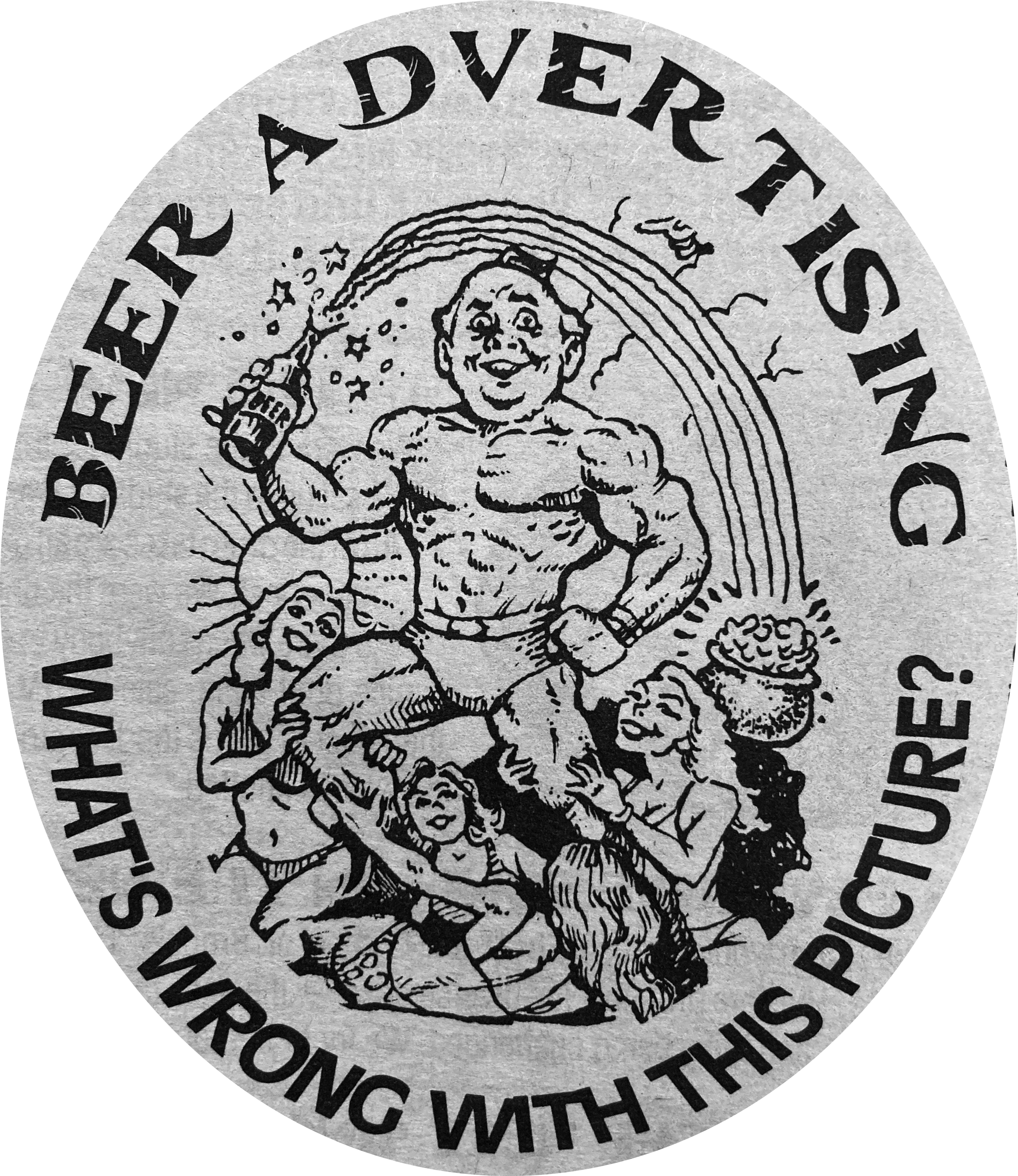Beer Advertising: What’s Wrong With This Picture?

BY GREGG KIRK
Big Shout Magazine, November 1995
FROSTED FANTASY
A group of guys sit along a river bank, fishing and remarking that life couldn’t get any better. Suddenly when one of them opens a cooler of his favorite domestic beer, bikini-clad women literally fall from the sky in parachutes to prove them wrong.
A “lone wolf” kind of guy walks into a deserted bar in some wild west ghost town and orders a bottle of of his favorite domestic brew. When he pops the cap, his world is changed into some kind of Twilight Zone/winter wonderland where snow falls on a summer day, and a beautiful woman appears, flirts with him, and somehow seems to understand all of his needs.
A group of friends in a bar argue over which channel to watch on television. When one of them taps the television set with a bottle of his favorite domestic beer, all channels blend together to satisfy all of their whims in a bizarre melding of sports, beauty pageants, drag racing… you name it.
What is the message here? That by drinking your favorite domestic beer, you can have control over time and space.
What is missing? How about the beer?
It’s been obvious since the 1960s that the Big Five American beer companies have felt it much more important to spend a majority of their revenue on elaborate advertising campaigns than on the ingredients of their products. They’ve been effective in producing a line of watery beers that are so similar in taste they are almost impossible to tell apart in blind taste tests. In order to establish an identity for these beverages, they’ve devised television and billboard advertisements that give their beers almost supernatural attributes. Not only have these preposterous campaigns been successful, they’ve dictated the average American’s taste in beer by blinding him/her to the fact that the beverage wasn’t supposed to taste like this in the first place.
COLD REALITY
Ignore they hype and pay attention to the beer itself. Here are some current advertising catch phrases that are the hallmarks of bad beer and bad beer making
ICE COLD — Anyone who know about beer knows that to enjoy the taste of the yeast and hops in the well-made beer, you should imbibe at a temperature no colder than 40 degrees Fahrenheit/4.4 degrees Celsius. In fact, a good portion of British and German ales are meant to be drunk at room temperature. Why? Because you simply can’t taste the ingredients the colder the beer is served. When you see a beer company or bar advertising their product as the coldest around, realize that most refrigerator settings only go so low. Any beer can be made cold, but why would you want to drink a cake of ice in a bottle?
SMOOTH — This word translates to “devoid of flavor.” In other words, the beer companies are so worried that a little hops on your tongue might have you running for the nearest bottle of Zima that they add corn and rice adjuncts to blunt the taste of what little hops are in the brew. This keeps it tasting as close to alcoholic seltzer water as possible. Apparently, after decades of conditioning and judging from how popular these domestic beers seem to be, this is what we want. Uh, once you snap out of your advertising-induced stupor and come across a well-made beer, you’ll realize they are wrong.
PREMIUM — It’s as simple as this — whenever I see this word on a can of beer, I know I’m in for a bad time. It’s a way for low-class beers to appear “uptown.” It’s like putting the word “gourmet” before the word “hotdog.” Don’t go there.
So what should you do? Keep it simple. Start by drinking as many microbrewed beers as possible. Find a taste you like, and then educate yourself. What is it exactly about the taste that turns you on? Is it a toasted barley flavor caused by a variation in malting? Is it a certain yeasty tang caused by a particular variety of yeast? Or is it a type of hops that either causes a bitterness you like or a floral sensation that passes through your nose? Find out what it is by asking a local beer snob. You’ll be able to spot him by his beer gut and the fact that he’s quaffing a draught of something with an unpronounceable name.
Another rule of thumb is this; You’re in safe territory if you drink a beer that follows Reinheitsgebot — the German purity law of 1516. It states simply that in making beer, you should only use four ingredients — yeast, water, hops and malted grain (barley and/or wheat). Not all good beers follow this procedure, and not all beer companies print the ingredients on their bottles for you to check. It’s not a guarantee that you will like the taste, but if you see the word on a label, you know you are in good hands. The only major brewery that follows Reinheitsgebot is the Boston Brewing Company that makes Samuel Adams products.
The only way to find out what is good is for you to go out and taste it. They say life is too short to drink bad beer. There’s not much time; you’d better get started.